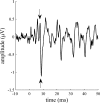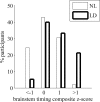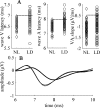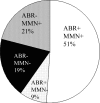Brainstem timing: implications for cortical processing and literacy
- PMID: 16251432
- PMCID: PMC6725554
- DOI: 10.1523/JNEUROSCI.2373-05.2005
Brainstem timing: implications for cortical processing and literacy
Abstract
The search for a unique biological marker of language-based learning disabilities has so far yielded inconclusive findings. Previous studies have shown a plethora of auditory processing deficits in learning disabilities at both the perceptual and physiological levels. In this study, we investigated the association among brainstem timing, cortical processing of stimulus differences, and literacy skills. To that end, brainstem timing and cortical sensitivity to acoustic change [mismatch negativity (MMN)] were measured in a group of children with learning disabilities and normal-learning children. The learning-disabled (LD) group was further divided into two subgroups with normal and abnormal brainstem timing. MMNs, literacy, and cognitive abilities were compared among the three groups. LD individuals with abnormal brainstem timing were more likely to show reduced processing of acoustic change at the cortical level compared with both normal-learning individuals and LD individuals with normal brainstem timing. This group was also characterized by a more severe form of learning disability manifested by poorer reading, listening comprehension, and general cognitive ability. We conclude that abnormal brainstem timing in learning disabilities is related to higher incidence of reduced cortical sensitivity to acoustic change and to deficient literacy skills. These findings suggest that abnormal brainstem timing may serve as a reliable marker of a subgroup of individuals with learning disabilities. They also suggest that faulty mechanisms of neural timing at the brainstem may be the biological basis of malfunction in this group.
Figures







References
-
- Amitay S, Ben-Yehudah G, Banai K, Ahissar M (2002b) Disabled readers suffer from visual and auditory impairments but not from a specific magnocellular deficit. Brain 125: 2272-2285. - PubMed
-
- Baldeweg T, Richardson A, Watkins S, Foale C, Gruzelier J (1999) Impaired auditory frequency discrimination in dyslexia detected with mismatch evoked potentials. Ann Neurol 45: 495-503. - PubMed
-
- Banai K, Ahissar M (2004) Poor frequency discrimination probes dyslexics with particularly impaired working memory. Audiol Neurootol 9: 328-340. - PubMed
Publication types
MeSH terms
Grants and funding
LinkOut - more resources
Full Text Sources
Research Materials
